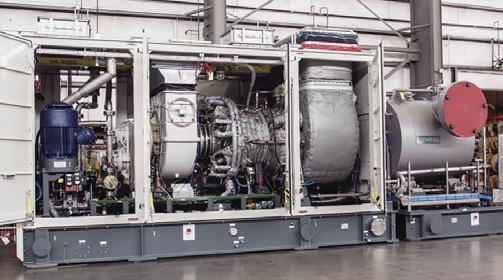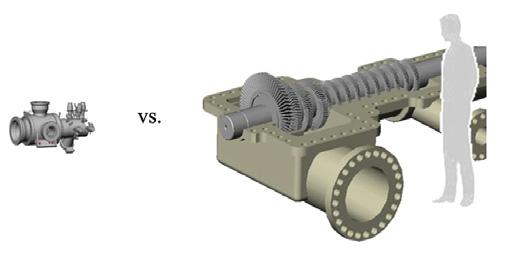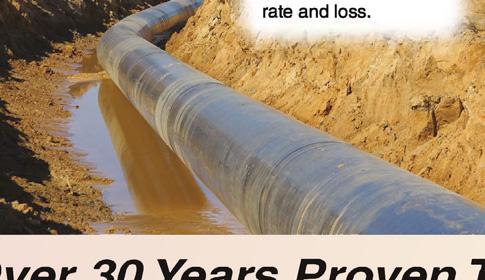
12 minute read
The future for compressor stations



Sam Miorelli, Scott Tackett and Arja Talakar, Siemens Energy, USA, on ushering in the next generation of compressor stations and addressing challenges related to cost, emissions and asset integrity.

Today, every oil and gas company faces pressure to reduce costs, lower emissions and ensure profitability in a future defined by market volatility. Pipeline operators, however, face a unique set of challenges.
Although the collapse in demand and the associated drop in production caused by the global pandemic temporarily alleviated pressure on North American midstream companies to build out new transportation infrastructure, the long-term need for pipelines and compressor stations is expected to remain strong. The question operators now face is how they can bring these facilities online quickly and sustainably while at the same








Figure 1. Siemens Energy modular compression station rendering with compression train inside a building.
Figure 2. Integrated SGT-400 compressor train. The factorycomplete package features on-package controls, factory test of complete drivetrain, crane and forklift handling, modular enclosure with open access.

time reducing emissions and maintaining the integrity of existing assets.
This article looks at how some of the latest advancements in rotating equipment, waste heat recovery and digitalisation can be leveraged to achieve these objectives.
Compressor station design The selection of turbomachinery within compressor stations is an area where significant opportunities exist for pipeline operators to reduce both emissions and lifecycle costs.
As far as design philosophies go, one trend we have seen in recent years on large capacity pipelines is the move away from several trains with gas turbine power blocks in the sub-30 000 hp unit range to fewer trains in the 50 000 hp range. Larger power blocks driven by modern gas turbines can translate into a lower cost per unit of horsepower, as well as reduced installation and land acquisition costs. For one particular ~500 mile pipeline project,1 Siemens Energy compared the capital costs of the following two compression options: ) 9 x 30 000 hp ISO trains installed across four stations.
) 5 x 55 000 hp ISO trains installed across four stations.
Using a net present value (NPV) analysis, capital savings of Option 2 were estimated at US$50 million. Recent projects that Siemens Energy has been involved with have shown that it is possible to increase these savings further using modular construction techniques combined with sole-source provisioning of trains. The degree of CAPEX savings achieved through modular fabrication will ultimately vary from project to project. Generally speaking, however, a 25 - 30% reduction in project spend is feasible when compared to a stick-built station.
Operational and maintenance expenses with Option 2 were also estimated to be 20% lower. These savings are mainly attributable to the fact that there are fewer trains and ancillary equipment for operators to maintain.
Another advantage of large power blocks is higher operating efficiency over a broader range of power loads, leading to a corresponding reduction in fuel consumption and emissions. For example, in the above comparison, the 5 x 55 000 hp configuration would consume an estimated 4.3 million ft3/d less fuel than the 9 x 30 000 hp option. At a gas cost of US$5/ mmBTU, this would result in savings of US$40 million over the life of the pipeline.
When it comes to the actual selection of the gas turbine, another trend that has emerged is the use of units equipped with modern dry low emissions (DLE) combustion systems.
Over the past decade, the reliability and performance of DLE combustion systems have been drastically improved. Many DLE units in operation today are seeing single-digit parts per million (ppm) NOx emission levels at power loads as low as 0%. The Siemens Energy SGT-400 industrial gas turbine (15 000 - 20 000 hp) with its enhanced DLE combustion hardware, for example, can maintain compliance with any applicable North American regulations down to 20% load. This is also the case with the larger SGT-750 industrial gas turbine model (50 000 - 55 000 hp), which can achieve 9 ppm NOx down to 20% load.
The fuel flexibility of DLE gas turbines has improved in recent years as well. Many models can now seamlessly switch between burning natural gas and other liquid fuels, including those with medium calorific values (MCV). The use of fuels with high contents of hydrogen is also possible. This is an essential characteristic with many pipeline projects planning to use co-firing in the coming years to reduce emissions.
By combining these gas turbine innovations with technologies for reducing or eliminating fugitive emissions from compressors, such as recompression or modern dry gas seals (both of which can be applied in brownfields), the carbon footprint of stations can be reduced rather substantially.
sCO2-based waste heat recovery For mechanically driven facilities, even further emissions reductions and efficiency gains can be realised by capturing and utilising waste heat from gas turbines. Although some compressor stations today use some form of waste heat recovery, the inherent drawbacks of traditional steam and Organic Rankine Cycle (ORC) technologies have prevented their application on a broader scale.
One of the primary limitations of steam cycles is the requirement for a plentiful water source and manual boiler operation. With many compressor stations located in remote locations without access to an ample supply of freshwater or where freezing can occur, these systems can be difficult to







justify. In recent years, ORC has emerged as a more attractive alternative to steam cycles. However, it also comes with drawbacks, including increased system complexity, exhaust temperature limitations, and environmental concerns related to the use of hazardous chemicals.
This year, Siemens Energy took an important step in expanding the possibilities for waste heat recovery at compressor stations by signing an agreement with TC Energy Corporation in Canada to install a water-free, waste heatto-power system at a facility in Alberta. The system was commercialised by Siemens Energy and Echogen Power Systems and uses supercritical carbon dioxide (sCO2) as the working fluid. sCO2 provides several advantages compared to ORC and steam cycles, including a more effective heat transfer profile, smaller footprint, lower installed costs, and the ability for remote operation.
The system at the compressor station in Alberta will capture waste heat from a gas-fired turbine and convert it into emissions-free power. The system will feed the grid with enough electricity to power roughly 10 000 Canadian homes. It will offset approximately 44 000 t/y of greenhouse gases, equivalent to taking 9000 vehicles off the road.
Embracing digital transformation In addition to taking advantage of the latest advancements in equipment, operators will also have to embrace digital transformation if they are to remain competitive in the coming years. An increasing number of companies now acknowledge this reality; however, many continue to show reluctance when using their data, owing to cybersecurity concerns and doubts about ROI.
While both areas should be closely scrutinised when deciding whether or not to implement a solution, operators should ask the potential implications and risks of not digitalising.
To quantify this, let us consider the application of
Figure 3. sCO2 turbine vs. steam turbine (~10MW size).








Siemens Energy’s cloud-based SmartPumpingTM solution to an 800 mile liquid pipeline with 18 pump stations driven by electric motors. At an average electricity rate of 7.5 cents/kWh, the annual utility bill for the line could be as high as US$30 million.
Now consider the massive volume of data generated from systems controlling valves, pumps, and motors in the stations. To provide some context, one of North America’s largest pipelines generates more than 20 000 data points of data every five seconds. This raw data holds tremendous value that is unlocked by processing and analysing it against the delivery schedules of various customer products, each with its own hydraulic characteristics.
SmartPumping analytics can take into account the power demands of those hydraulic characteristics and propose parameters aimed at helping operators reduce electrical loads in a process known as batch optimisation. The application can also be used to leverage utility price differentials between pump stations, shifting either downstream or upstream some of the power load of one station that’s subject to relatively expensive utility rates to another pump station where utility charges are less.
In this particular case, just a 1% reduction in power consumption at each of the 18 pumping stations along the 800 mile route could equate to utility bill savings of US$7.5 million over five years. Depending on the source of power generation, it could also translate into a reduction of up to 70 000 metric t of CO2 emissions.
Significant opportunities also exist to optimise maintenance and improve asset utilisation through digitalisation. Among the many different solutions available on the marketplace today, asset performance management (APM) software has garnered a great deal of interest, as it has been used extensively in industries that are widely recognised as being far along on the digital transformation maturity curve (e.g. aviation, manufacturing, chemical processing, etc.).
Last year, Siemens Energy launched its own APM platform (APM4O&G), which is explicitly geared toward oil and gas facilities, including compressor stations.
APM4O&G is a diagnostic and decision-support tool that combines Bentley Systems field-proven asset performance software platform (AssetWise) with Siemens Energy’s domain expertise and know-how in oil and gas equipment operations and maintenance. The solution is delivered as-a-service (i.e. subscription-based) and is designed to help operators ensure that every piece of equipment in their facility performs its expected function within a specific operating and business context.
As my colleague Matthew Grimes – along with Stuart Mitchell from Proflex Technologies – discussed in the September 2021 issue of World Pipelines, digitalisation also enables faster and more accurate detection of spontaneous leaks at a much lower cost than methods, such as fibre optic sensing. In the article, Mr. Grimes and Mr. Mitchell provided an overview of a recent collaboration between our two companies to offer IoT-based spontaneous leak detection as-a-service.2
The solution leverages ProFlex Technologies’ novel Negative Press Wave (NPW)-based remote monitoring and complex data processing algorithms to detect and localise small pipeline leaks within seconds. Once a leak event has been identified, Siemens Energy’s cloud-based IoT system analyses the leak data in real-time, notifying users through mobile devices, laptops, or via desktop or SCADA system. Leak location in the form of latitude and longitude co-ordinates is presented on a pipeline asset map and has proven to be accurate to around 20 - 50 ft.
Cybersecurity Of course, any conversation about the digitalisation of pipeline assets cannot be had without a discussion of cybersecurity.
Cyberattacks now threaten the core value proposition of every oil and gas organisation. Unfortunately, the interconnected and distributed nature of pipelines makes them a desirable target for malicious parties. This is particularly the case with ageing compressor and pumping stations, which were not explicitly designed with connectivity in mind.
Today, the primary challenge when it comes to protecting midstream networks from potential cyber intrusions is visibility. Most operators don’t have the proper tools or domain expertise to identify possible weak points within their architectures. In some cases, intrusions may have already occurred but gone undetected.
Ironically, the key to addressing this challenge is more digitalisation. The use of artificial intelligence (AI)-based tools that can rapidly detect when an attack is occurring represent arguably the most advanced protection measure available today. These tools have been successfully applied across other industries. Historically, however, they have been challenging to scale for IT and OT networks spread over millions of square miles of remote terrain.
Siemens Energy set out to solve this problem by partnering with SparkCognition to deploy DeepArmor Industrial, a novel cyber defense system designed to protect endpoint and remote OT assets across the energy value chain.
DeepArmor features an AI-driven system that provides continuous monitoring and the capability to quickly detect cyberattacks, delivering next-generation antivirus, threat detection, application control, and zero-day attack prevention to endpoint transmission and distribution assets. The collaborative effort aims to help the midstream and broader oil and gas industry address its cybersecurity challenges by providing operators, for the first time, with fleet-level monitoring and protection capabilities.
Collaborating with strategic partners Midstream companies are under intense pressure to simultaneously reduce both costs and emissions. It is sometimes perceived that addressing one of these challenges must occur at the expense of the other. At Siemens Energy, our experience with large-scale compression projects across the globe has shown this does not have to be the case.
The key to success lies in engaging with strategic partners who have shared goals and can help choose the right combination of technologies and strategies to deploy. To this end, operators can benefit by embracing relationships with vendors and OEMs that are more open and collaborative than closed and transactional. The complex issues the industry has to solve in the coming years – particularly with regards to decarbonisation – will inevitably require new ways of both thinking and working.
References
1. Length – 491 miles; flowrate – 2000 million ft3/d; MAOP – 1750 psi; diameter – 42 in.; sas price – US$5/mmBTU; operating life – 30 years. 2. Proflex Technologies Spontaneous Leak Detection As-a-service, powered by Siemens Energy IoT.









